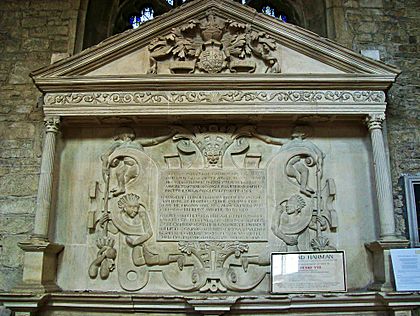Edmund Harman facts for kids
Edmund Harman (born around 1509, died 1577) was a special kind of doctor called a barber-surgeon for Henry VIII of England, a famous king. He was also a member of the king's close group of advisors, known as the Privy Chamber. Harman worked alongside other important people like Thomas Wendy and George Owen.
Contents
Who Was Edmund Harman?
Edmund Harman played an important role in King Henry VIII's court. As a barber-surgeon, he would have performed various medical tasks, from cutting hair to minor surgeries. Being part of the Privy Chamber meant he was trusted by the king and had access to him.
Harman's Early Career
In February 1536, Harman was given an important job. He became the bailiff of Hovington. This meant he was in charge of managing a large house and farm there. He looked after these properties for a young lord who was not yet old enough to manage them himself.
Becoming a Prominent Citizen
Harman became a well-known person in the town of Burford in the 1540s. This happened because King Henry VIII was closing down many monasteries at the time, a period known as the Dissolution of the Monasteries. Harman and his wife were given Burford Priory, which was a former religious building. This made them important landowners in the area.
The Mysterious Harman Memorial
Edmund Harman was buried in a church in Taynton, Oxfordshire. However, his very fancy memorial is in the Church of St John the Baptist, Burford, which is about a mile and a half away. This monument is quite special and has some interesting features.
Family on the Monument
The memorial shows carvings of Harman's large family. It includes his nine sons and seven daughters. Sadly, only two of his daughters lived longer than their parents. The monument was likely designed to show his family's importance and legacy.
Native Americans in Stone
One of the most unusual things about Harman's memorial is that it might have the earliest carvings of Native Americans in Britain. You can see four figures that look like South American Indians. They are wearing feathered headdresses, and there's even a jaguar carved next to them. These figures surround the main plaque on the memorial.
The Latin writing on the monument doesn't explain why these images are there. Some historians believe that Harman's family might have been involved in early trips to the Americas for exploration or trade. It's also possible that the images were copied from pictures in a Flemish book that came out a few years before the monument was made. This unique carving adds a lot of mystery to Edmund Harman's story!
Images for kids



